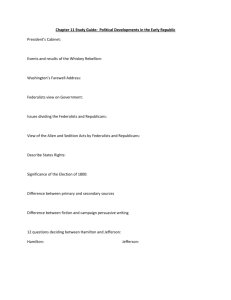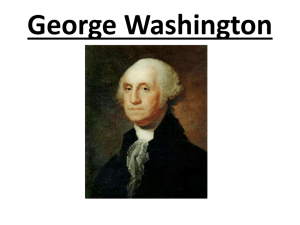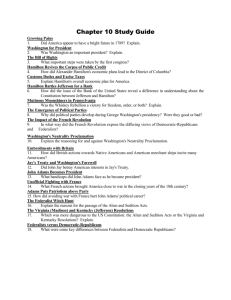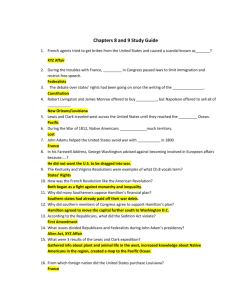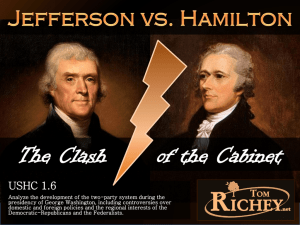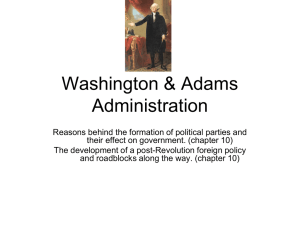Section 7 - The First Political Parties
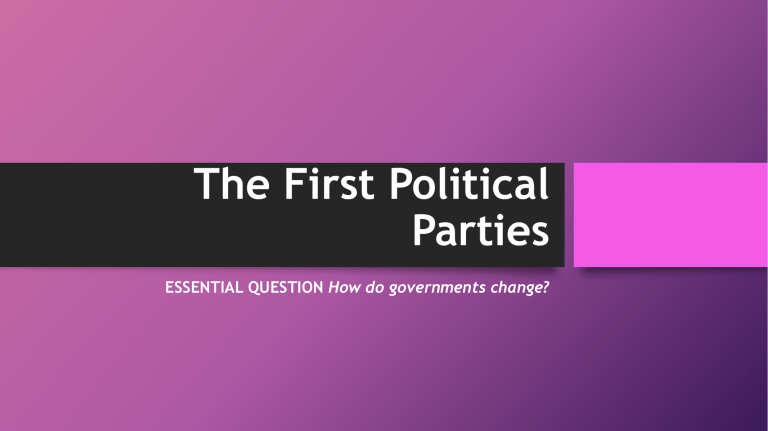
The First Political
Parties
ESSENTIAL QUESTION How do governments change?
Opposing Parties
Guiding Question: How did different opinions lead to the first political parties?
The American people generally admired President Washington and his service to the nation.
• harsh attacks appeared from time to time in newspapers.
• One paper even called Washington "the scourge and the misfortune of his country.“
Most of the attacks on Washington came from supporters of Thomas Jefferson.
• They hoped to weaken support for the policies of Alexander Hamilton, which the president seemed to favor.
• by 1796, the supporters of Jefferson and Hamilton were beginning to form the nation's first political parties.
At that time, many Americans thought political parties were harmful to good government.
• The Constitution made no mention of parties because its authors saw no good use for them. Washington warned that they would divide the nation.
To others, though, it seemed natural that people would disagree about issues.
• They also knew that people who hold similar views tend to band together.
Washington's cabinet was clearly divided on key issues.
• Alexander Hamilton and Thomas Jefferson had very different views.
• They disagreed on economic policy and foreign relations.
• They did not share the same opinion on the power of the federal government or on the meaning of the Constitution.
• Even Washington was partisan—clearly favoring one faction.
• The president believed he stood above politics, but he usually supported
Hamilton's views.
Party # 1 – Federalists
Led by Hamilton, this group favored a strong federal government.
• They believed the Constitution gave government "implied" powers. These implied powers are not enumerated, or listed clearly in the Constitution.
• Federalists believed Congress could make all laws "necessary and proper" to carry out its enumerated powers.
• Agreed to have a federal bank.
• Federalists supported representative government, in which elected officials ruled in the people's name. They did not believe it was wise to let the public become too involved in politics.
Party # 2 - Democratic-Republicans, or
Republicans
The Democratic-Republicans, or Republicans, stood against the Federalists.
• Jefferson and Madison led this faction.
• They believed in a strict reading of the Constitution.
• They rejected the Federalist idea of implied powers. They believed congressional powers were limited to what is absolutely necessary to carry out the enumerated powers (powers listed directly in the Constitution).
• Disagreed with the Federal Bank
• thought that educated, wealthier men should hold public officials. They did not trust ordinary people to make good decisions.
• feared a strong central government controlled by only a few people. They believed that democracy and liberty would be safe only if ordinary people took part fully in government.
Washington’s Reactions to the Creation of 2
Parties
The growing differences between the parties—and between Hamilton and Jefferson—troubled President
Washington.
• He tried to get his two cabinet members to work out their differences.
• Washington's efforts to get Jefferson and Hamilton to work together failed.
• The split was so strong that Jefferson left the cabinet and his job as secretary of state.
• Soon afterward, Hamilton resigned as secretary of the treasury.
• As the election of 1796 approached, the two parties each prepared to seek control of the presidency.
The Presidential Election of 1796
To prepare for the election, both parties held caucuses -At these meetings, members of Congress and other leaders nominated, or chose, their parties' candidates for office.
• Each party chose two presidential candidates, and the electors voted for any two.
• The Federalists chose John Adams and Charles Pinckney.
• The Republicans chose Thomas Jefferson and Aaron Burr.
• There was no candidate identified as a vice presidential candidate on the ballot.
• The Federalists carried the New England region.
• Republican strength lay in the Southern states.
• Adams got 71 electoral votes, winning the election.
• Jefferson finished second with 68 votes.
• Under the rules of the Constitution at that time, the person with the second-highest electoral vote total—Jefferson—became vice president.
• The administration that took office on March 4, 1797, had a Federalist president and a Republican vice president.
John Adams as President
Guiding Question: What important events occurred during the presidency of John Adams?
John Adams spent most of his life in public service.
• He was well-known as one of Massachusetts's most active patriots in the period before and during the
Revolutionary War.
• He served two terms as vice president under Washington before becoming president.
• His time in office, however, was troubled.
Alien and Sedition Acts
When the public found out about the XYZ affair, many grew angry at foreign attempts to influence their government.
• They became more suspicious of aliens—residents who are not citizens.
• Many Europeans who had come to the United States in the 1790s supported the ideals of the French
Revolution.
• Some Americans questioned whether these aliens would remain loyal if the United States went to war with
France.
• In response to these concerns, Federalists in 1798 passed the Alien and Sedition Acts.
• Sedition (sih • DIH • shuhn) means activities aimed at weakening the government.
• The Alien and Sedition Acts allowed the president to imprison aliens.
• The president could also deport—send out of the country— those thought to be dangerous.
• President Adams was a strong supporter of these laws.
• Democratic Republicans argued against these acts.
